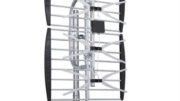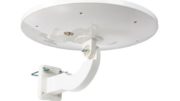By now you’ve probably read or heard about this “FCC Repack” that’s taking place. Throughout the last decade, the FCC has been working on a grand plan to take away television channels so that there can be more room for cellular data. Back in 2017 they announced the results of their efforts, and almost a year later we published our guide for when this whole thing would affect you.
The bottom line for enthusiasts
Most people with an over-the-air antenna won’t see a lot of changes as a result of all of this. There’s still plenty of available space in most cities and most stations aren’t moving too much. The antenna you have will probably be fine and you’ll get messages on your TV telling you when it’s time to rescan for channels. You’ll do that, and then everything will be fine.
However, there are a few stations that are moving into the VHF Low band, and that could be a problem for you.
A quick discussion of VHF-Low and why it’s a problem
VHF-Low is the name we give to channels 2-6. Because you need a bigger antenna for lower frequencies, these channels require the biggest antenna of all. If you want to get them over the air you’ll need a large outdoor antenna, unless you’re within 10-15 miles of them.
Back in the early days of television, VHF Low was used a lot, of course. In fact channels 2-6 were valued real estate. But then, people used to take it as a point of pride that they had the biggest and most powerful antenna possible on their roofs. When this all began, most people were centered around cities and suburban sprawl had just begun.
Today, people like small sleek antennas and unfortunately that sort of antenna isn’t good at VHF Low at all.
What stations are affected?
Here’s a list courtesy of rabbitears.info. It shows all the stations in all the cities that are moving into the VHF-Low range, when they were previously on much higher frequencies.
| New Ch |
Curr Ch |
Callsign | City of License |
|---|---|---|---|
| 2 | 14 | WHDF | FLORENCE, AL |
| 2 | 21 | WSBE-TV | PROVIDENCE, RI |
| 2 | 16 | WGGS-TV | GREENVILLE, SC |
| 2 | 32 | WVIR-TV | CHARLOTTESVILLE, VA |
| 3 | 42 | WGGN-TV | SANDUSKY, OH |
| 4 | 42 | KWHY-TV | LOS ANGELES, CA |
| 4 | 33 | WNGH-TV | CHATSWORTH, GA |
| 4 | 44 | WTLW | LIMA, OH |
| 4 | 13 | WQED | PITTSBURGH, PA |
| 5 | 23 | KRCB | COTATI, CA |
| 5 | 26 | KVCR-DT | SAN BERNARDINO, CA |
| 5 | 23 | WJSP-TV | COLUMBUS, GA |
| 5 | 19 | WGBH-TV | BOSTON, MA |
| 5 | 26 | WNYB | JAMESTOWN, NY |
| 5 | 27 | WTNB-CD | CLEVELAND, TN |
| 6 | 35 | WOUC-TV | CAMBRIDGE, OH |
| 6 | 46 | WKBS-TV | ALTOONA, PA |
There aren’t that many of them and many of them aren’t really mass-market. Some are public television stations, while others carry religious programming. You might find you could live without them, but if these stations are important to you, that’s ok too. It’s all about planning.
What to do if your favorite station is moving to VHF-Low
If you’re within 10-15 miles of the city center there’s a chance that you won’t have to do anything. Small indoor antennas do a very good job at that range, no matter what frequency you’re using. However, if you’re further out than that, you might need to change antennas. You might just need one of those old-school antennas like you see at the top of this page.
If you don’t know for sure, or if you have any questions, give the folks at Solid Signal a call. The number is 888-233-7563 and they can answer all your questions during East Coast business hours.





